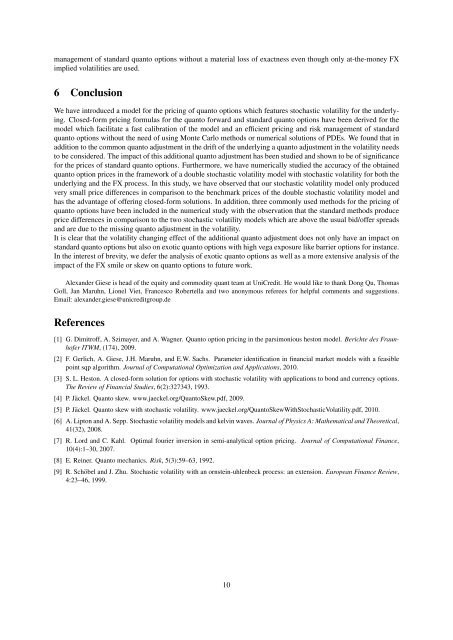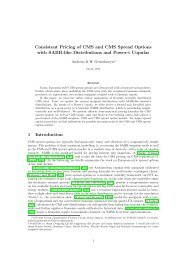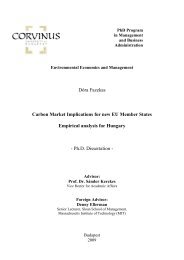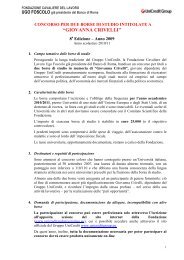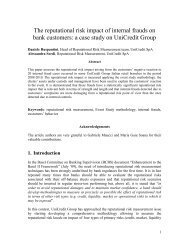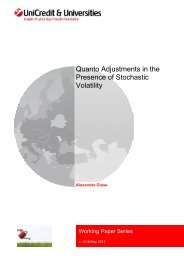Quanto Adjustments in the Presence of Stochastic Volatility
Quanto Adjustments in the Presence of Stochastic Volatility
Quanto Adjustments in the Presence of Stochastic Volatility
You also want an ePaper? Increase the reach of your titles
YUMPU automatically turns print PDFs into web optimized ePapers that Google loves.
management <strong>of</strong> standard quanto options without a material loss <strong>of</strong> exactness even though only at-<strong>the</strong>-money FX<br />
implied volatilities are used.<br />
6 Conclusion<br />
We have <strong>in</strong>troduced a model for <strong>the</strong> pric<strong>in</strong>g <strong>of</strong> quanto options which features stochastic volatility for <strong>the</strong> underly<strong>in</strong>g.<br />
Closed-form pric<strong>in</strong>g formulas for <strong>the</strong> quanto forward and standard quanto options have been derived for <strong>the</strong><br />
model which facilitate a fast calibration <strong>of</strong> <strong>the</strong> model and an efficient pric<strong>in</strong>g and risk management <strong>of</strong> standard<br />
quanto options without <strong>the</strong> need <strong>of</strong> us<strong>in</strong>g Monte Carlo methods or numerical solutions <strong>of</strong> PDEs. We found that <strong>in</strong><br />
addition to <strong>the</strong> common quanto adjustment <strong>in</strong> <strong>the</strong> drift <strong>of</strong> <strong>the</strong> underly<strong>in</strong>g a quanto adjustment <strong>in</strong> <strong>the</strong> volatility needs<br />
to be considered. The impact <strong>of</strong> this additional quanto adjustment has been studied and shown to be <strong>of</strong> significance<br />
for <strong>the</strong> prices <strong>of</strong> standard quanto options. Fur<strong>the</strong>rmore, we have numerically studied <strong>the</strong> accuracy <strong>of</strong> <strong>the</strong> obta<strong>in</strong>ed<br />
quanto option prices <strong>in</strong> <strong>the</strong> framework <strong>of</strong> a double stochastic volatility model with stochastic volatility for both <strong>the</strong><br />
underly<strong>in</strong>g and <strong>the</strong> FX process. In this study, we have observed that our stochastic volatility model only produced<br />
very small price differences <strong>in</strong> comparison to <strong>the</strong> benchmark prices <strong>of</strong> <strong>the</strong> double stochastic volatility model and<br />
has <strong>the</strong> advantage <strong>of</strong> <strong>of</strong>fer<strong>in</strong>g closed-form solutions. In addition, three commonly used methods for <strong>the</strong> pric<strong>in</strong>g <strong>of</strong><br />
quanto options have been <strong>in</strong>cluded <strong>in</strong> <strong>the</strong> numerical study with <strong>the</strong> observation that <strong>the</strong> standard methods produce<br />
price differences <strong>in</strong> comparison to <strong>the</strong> two stochastic volatility models which are above <strong>the</strong> usual bid/<strong>of</strong>fer spreads<br />
and are due to <strong>the</strong> miss<strong>in</strong>g quanto adjustment <strong>in</strong> <strong>the</strong> volatility.<br />
It is clear that <strong>the</strong> volatility chang<strong>in</strong>g effect <strong>of</strong> <strong>the</strong> additional quanto adjustment does not only have an impact on<br />
standard quanto options but also on exotic quanto options with high vega exposure like barrier options for <strong>in</strong>stance.<br />
In <strong>the</strong> <strong>in</strong>terest <strong>of</strong> brevity, we defer <strong>the</strong> analysis <strong>of</strong> exotic quanto options as well as a more extensive analysis <strong>of</strong> <strong>the</strong><br />
impact <strong>of</strong> <strong>the</strong> FX smile or skew on quanto options to future work.<br />
Alexander Giese is head <strong>of</strong> <strong>the</strong> equity and commodity quant team at UniCredit. He would like to thank Dong Qu, Thomas<br />
Goll, Jan Maruhn, Lionel Viet, Francesco Robertella and two anonymous referees for helpful comments and suggestions.<br />
Email: alexander.giese@unicreditgroup.de<br />
References<br />
[1] G. Dimitr<strong>of</strong>f, A. Szimayer, and A. Wagner. <strong>Quanto</strong> option pric<strong>in</strong>g <strong>in</strong> <strong>the</strong> parsimonious heston model. Berichte des Fraunh<strong>of</strong>er<br />
ITWM, (174), 2009.<br />
[2] F. Gerlich, A. Giese, J.H. Maruhn, and E.W. Sachs. Parameter identification <strong>in</strong> f<strong>in</strong>ancial market models with a feasible<br />
po<strong>in</strong>t sqp algorithm. Journal <strong>of</strong> Computational Optimization and Applications, 2010.<br />
[3] S. L. Heston. A closed-form solution for options with stochastic volatility with applications to bond and currency options.<br />
The Review <strong>of</strong> F<strong>in</strong>ancial Studies, 6(2):327343, 1993.<br />
[4] P. Jäckel. <strong>Quanto</strong> skew. www.jaeckel.org/<strong>Quanto</strong>Skew.pdf, 2009.<br />
[5] P. Jäckel. <strong>Quanto</strong> skew with stochastic volatility. www.jaeckel.org/<strong>Quanto</strong>SkewWith<strong>Stochastic</strong><strong>Volatility</strong>.pdf, 2010.<br />
[6] A. Lipton and A. Sepp. <strong>Stochastic</strong> volatility models and kelv<strong>in</strong> waves. Journal <strong>of</strong> Physics A: Ma<strong>the</strong>matical and Theoretical,<br />
41(32), 2008.<br />
[7] R. Lord and C. Kahl. Optimal fourier <strong>in</strong>version <strong>in</strong> semi-analytical option pric<strong>in</strong>g. Journal <strong>of</strong> Computational F<strong>in</strong>ance,<br />
10(4):1–30, 2007.<br />
[8] E. Re<strong>in</strong>er. <strong>Quanto</strong> mechanics. Risk, 5(3):59–63, 1992.<br />
[9] R. Schöbel and J. Zhu. <strong>Stochastic</strong> volatility with an ornste<strong>in</strong>-uhlenbeck process: an extension. European F<strong>in</strong>ance Review,<br />
4:23–46, 1999.<br />
10


